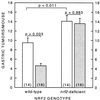Sensitivity to carcinogenesis is increased and chemoprotective efficacy of enzyme inducers is lost in nrf2 transcription factor-deficient mice
- PMID: 11248092
- PMCID: PMC30667
- DOI: 10.1073/pnas.051618798
Sensitivity to carcinogenesis is increased and chemoprotective efficacy of enzyme inducers is lost in nrf2 transcription factor-deficient mice
Abstract
Induction of phase 2 enzymes, which neutralize reactive electrophiles and act as indirect antioxidants, appears to be an effective means for achieving protection against a variety of carcinogens in animals and humans. Transcriptional control of the expression of these enzymes is mediated, at least in part, through the antioxidant response element (ARE) found in the regulatory regions of their genes. The transcription factor Nrf2, which binds to the ARE, appears to be essential for the induction of prototypical phase 2 enzymes such as glutathione S-transferases (GSTs) and NAD(P)H:quinone oxidoreductase (NQO1). Constitutive hepatic and gastric activities of GST and NQO1 were reduced by 50-80% in nrf2-deficient mice compared with wild-type mice. Moreover, the 2- to 5-fold induction of these enzymes in wild-type mice by the chemoprotective agent oltipraz, which is currently in clinical trials, was almost completely abrogated in the nrf2-deficient mice. In parallel with the enzymatic changes, nrf2-deficient mice had a significantly higher burden of gastric neoplasia after treatment with benzo[a]pyrene than did wild-type mice. Oltipraz significantly reduced multiplicity of gastric neoplasia in wild-type mice by 55%, but had no effect on tumor burden in nrf2-deficient mice. Thus, Nrf2 plays a central role in the regulation of constitutive and inducible expression of phase 2 enzymes in vivo and dramatically influences susceptibility to carcinogenesis. Moreover, the total loss of anticarcinogenic efficacy of oltipraz in the nrf2-disrupted mice highlights the prime importance of elevated phase 2 gene expression in chemoprotection by this and similar enzyme inducers.
Figures



Comment in
-
Chemoprevention: increased potential to bear fruit.Proc Natl Acad Sci U S A. 2001 Mar 13;98(6):2941-3. doi: 10.1073/pnas.071042698. Proc Natl Acad Sci U S A. 2001. PMID: 11248007 Free PMC article. Review. No abstract available.
References
-
- Miller E C, Miller J A. Pharmacol Rev. 1966;18:805–838. - PubMed
-
- Lubet R A, Connolly G M, Nebert D W, Kouri R E. Carcinogenesis. 1983;4:513–517. - PubMed
-
- Boberg E W, Miller E C, Miller J A, Poland A, Liem M. Cancer Res. 1983;43:5163–5173. - PubMed
-
- Wattenberg L W. Cancer Res. 1985;45:1–8. - PubMed
-
- Kelloff G J, Boone C W, Crowell J A, Steele V E, Lubet R A, Doody L A, Malone W F, Hawk E T, Sigman C C. J Cell Biochem Suppl. 1996;26:1–28. - PubMed
Publication types
MeSH terms
Substances
Grants and funding
LinkOut - more resources
Full Text Sources
Other Literature Sources
Medical
Molecular Biology Databases
Research Materials
Miscellaneous

